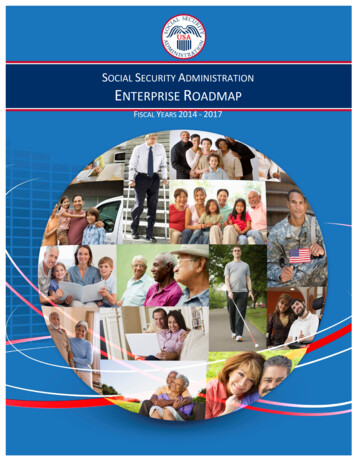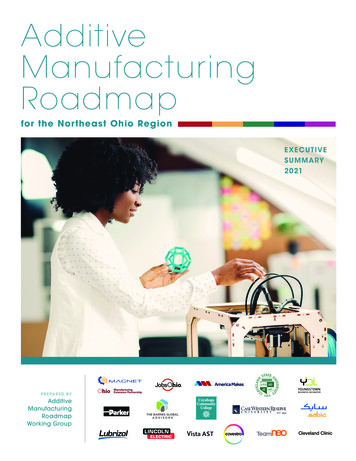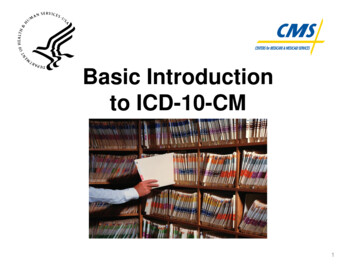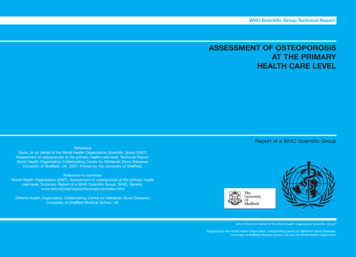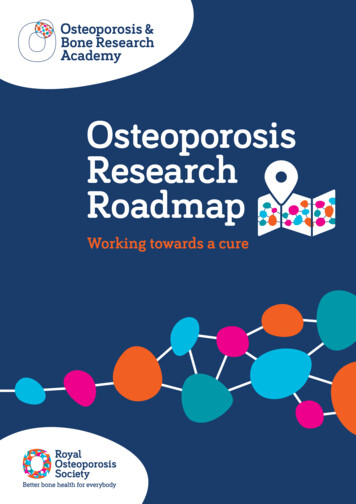
Transcription
OsteoporosisResearchRoadmapWorking towards a cureto a cure for osteoporosis
ContentsOsteoporosis is a devastating disease3Royal Osteoporosis Society:a future without osteoporosis4More than 3.5 million people in the UKare estimated to have osteoporosis4Osteoporosis Research Roadmap:working towards a cureOver 500,000 fragility fracturesper year in the UK5Causes and mechanisms6Novel technology for skeletal assessment7Optimising effectiveness of assessmentand treatment7Patient Advocacy FrameworkOlder people with hip fractures occupy4,000 NHS beds at any one time89Funding and support for researchers210Broken bones caused by osteoporosiscost the UK more than 4.5 billionevery year
Osteoporosis Research Roadmapworking towards a cureOsteoporosis is a devastating diseaseOsteoporosis, literally “porous bones”, is acommon condition in which there is a decreasein the amount of bone and weakening of itsstructure, resulting in fragile bones that canbreak after a simple trip or fall.These fractures not only cause severe pain andsignificant short-term impact on quality of life,but can result in life-changing, long-termdisability and loss of independence.Osteoporosis leads to easily broken bonesfrom a trip or fall – termed ‘fragility fractures’There are 3.5 million people in the UK living withosteoporosis and this number is rising rapidlydue to the ageing population. Despite significantadvances in osteoporosis research that have ledto real improvements in people’s lives, there arestill considerable challenges. Consequently,there is an urgent need to intensify the searchfor answers that can help us beat this cruelcondition and prevent future generations fromsuffering the misery of broken bones.One in two women and one in five menaged over 50 are expected to break a boneImage of normal humanbone structure (top) andosteoporotic bone (bottom).By kind permission ofProfessor Tim Arnett(t.arnett@ucl.ac.uk)One in three people with osteoporosisare in long-term pain described as‘severe’ or ‘unbearable’3
Royal Osteoporosis Societya future without osteoporosisOur vision of a future without osteoporosis will be achieved through work to: improve the bone health of our nation and prevent osteoporosis; influence healthcare providers and professionals to deliver high quality care so thatall people at high risk of fragility fractures are assessed and treated appropriately; influence policy makers so that osteoporosis gets the priority and funding that it deserves; provide the best information, support and services to help people with osteoporosis live well; drive the research and development of new treatments and preventative strategies that willultimately cure osteoporosis.Osteoporosis and Bone Research Academyputting cure centre stageOur Osteoporosis and Bone Research Academy was launched in February2019 by ROS President, Her Royal Highness the Duchess of Cornwall. It bringstogether leading national and international expertise with patient advocates.The Academy has undertaken evidencereviews to identify gaps in osteoporosisresearch and patient care, and has generateda comprehensive programme of projects toaddress the resulting key priorities.The Academy’s mission is to achieve a curefor osteoporosis through the developmentof novel strategies to optimise bone healthacross the whole lifecourse, and to implementnew practices to ensure that every person atincreased risk of fracture is identified, assessedand treated appropriately.ROS President, Her Royal Highness the Duchess of Cornwall4
Osteoporosis Research Roadmapworking towards a cureOsteoporosis Research Roadmapworking towards a cureThe Research Roadmap represents the culmination of the first phase of the Academy workplan,setting out the identified knowledge gaps and the planned research projects.Our Osteoporosis and Bone Research AcademyOsteoporosisevidencereviewNew projectsIdentificationof ,assessment andtreatmentCure: a world without fragility fracturesThe Academy has identified key gaps in research and clinical care across three phases of the lifecourse:early growth through development in the womb and during childhood until peak bone mass is achievedin young adulthood; maintenance of bone mass through adulthood; and minimisation of bone lossand fracture risk in older age. The overarching aim is to ensure that bone development, growth andmaintenance are optimised and bone loss and fracture risk are minimised (represented as the orangecurve in the diagram below). This results in healthy bone ageing and ensures that all individuals avoid theimpaired bone health trajectory (lower blue curve) that results in osteoporosis and fractures.Improving the bone health lifecourse through researchMaximisepeakMaintainpeakMinimisefracture riskBuild strongbones for lifeConsolidatebone bankFracture freehealthy ageingLife-longhealthy bonesResearchBone strengthOptimal bone health trajectoryImpaired bone health trajectoryLifecourseOsteoporosisand fractures5
Academy researchprioritiesThe three Academy working groups(Causes, Effectiveness and Technology)have generated an integrated workplanaddressing three synergistic and closelyinterlinked research areas: Causes andmechanisms; Novel technology for skeletalassessment; Optimising effectiveness ofassessment and treatment.ResearchprioritiesCauses and mechanismsThere are many factors that influence bone healthand many routes to sub-optimal peak bone mass andosteoporosis. This journey starts as early as duringdevelopment in the womb.The causes and mechanisms work stream willestablish novel genetic and non-genetic causes,in particular:Causes andmechanismsRareconditions interrogating existing genome-wide association(genetic) data to develop new and better treatments; exploring mechanisms linking diet and the gutmicrobiome (the microorganisms in our bowel)to bone health; studying rare disorders, such as pregnancy andlactation associated osteoporosis, to understandmechanisms that may be applicable toosteoporosis more generally, and to improve theassessment and care of people suffering fromthese devastating conditions.Novel geneticand non-geneticcausesNew and bettertreatmentsWhilst there is already an impressive array oftreatments for osteoporosis, greater understandingof underlying mechanisms will generate new andmore effective preventive and therapeutic strategies,dramatically changing the outlook for patients.Pregnancy and lactation associated osteoporosisis a rare condition when bones break (fracture)easily around the time a woman is giving birth.These fractures usually happen in the spine orsometimes the hip, and cause pain and disability.6Scanning electron micrograph of activatedosteoclast and resorption pits. By kind permissionof Professor Tim Arnett (t.arnett@ucl.ac.uk)
Osteoporosis Research Roadmapworking towards a cureNoveltechnologyfor skeletalassessmentDetection ofvertebral fractureson routineimagingNovel technology for skeletal assessmentNew technologies are the particular focus here,bringing together cutting-edge advances: to facilitate opportunistic detection of vertebralfractures on routine hospital imaging;Newmeasures ofbone strength to use big data resources such as NHS clinicalrecords and UK Biobank to identify novel riskfactors;Big dataresearch to derive new measures of bone strength, forexample by applying machine learning algorithmsto images obtained from diagnostic scans.Optimal use of state-of-the-art technology willlead to improved algorithms for risk assessment,enable the diagnosis of previously undetectedspinal fractures and provide more accurateestimation of bone strength. Such advances willresult in a step change in the ability to assessfracture risk and identify those who will benefitfrom osteoporosis treatments.Vertebral fracturedetected on aroutine CT scan.Optimising effectiveness of assessmentand treatmentOptimisingeffectivenessof assessmentand treatmentOptimisedcare pathwayfrom fractureto therapyAutomatedfracture riskassessmentPersonalisedtherapy andimprovedadherenceThe effectiveness work stream will developan integrated approach to the automatedassessment of fracture risk, selection ofappropriate therapy and optimisation oftreatment adherence. This will provide: universal access to automatic fracture riskassessment in primary care; personalisation of therapy targeted to theindividual level of fracture risk; achievement of an automated care pathwayin people who fracture, including assessment,treatment and monitoring.The undertreatment of osteoporosisremains a key care gap, and successfullyensuring that every person at high fracturerisk receives appropriate assessment andtreatment for osteoporosis will result in amajor advance in the care of thesevulnerable patients.7
Patient Advocacy FrameworkPatients’ perspectives and inputs are key to the ongoingsuccess of this work. Academy patient advocates sit onthe Advisory Committee and expert Working Groups asequal partners and have been fully involved in setting theresearch priorities.A critical element in the development of the ResearchRoadmap is the contribution of wider patient insight,to ensure that patients’ priorities and expectations arecomprehensively represented and incorporated. Patients’views on proposed research topics were received from2,000 ROS members. All the research priorities wererated as either ‘extremely’ or ‘very’ important by at least80% of respondents.Endorsement of the Research Priorities by patients or carersof people with osteoporosis is essential if the Academy workplan is to achieve a real-world impact on the lives of peopleliving with osteoporosis.ROS staff with some of the Academy’s Patient Advocates.8I really welcome theRoyal Osteoporosis Society’scommitment to involvingpatients and the public in allareas of their work. I hopethat by being part of a teamof patient advocates in theAcademy, we can help toshare our insights from apatient perspective contributing to the relevanceand effectiveness ofresearch.Mary Bishop, Academy AdvisoryCommittee Patient Advocate.
Osteoporosis Research Roadmapworking towards a cureROS Aspiring Leaders Initiative supporting thenext generation of clinical and research leadersIf the ROS Academy’s mission is to succeed, thereis an urgent need to support the next generationof clinical and research leaders in osteoporosisand metabolic bone health.The Aspiring Leaders initiative, in collaborationwith the Faculty of Medical Leadership andManagement, presents an innovative, forwardlooking and exciting leadership course coveringthemes such as: personal effectiveness; leadingthrough complexity; high performance teamworking; and influencing government policy.The course takes on 12 outstanding academics/clinicians each year with application through initialnomination by a senior colleague.Only by nurturing thebest and brightest minds inosteoporosis can we createa pipeline of leaderscapable of finding a cure.Lauren Wiggins, Director, Osteoporosisand Bone Research AcademyI believe the AspiringLeaders Programme has beenan invaluable experience forme and has significantlyenhanced both my academicand clinical work. I feel moreempowered to ‘step up’ tomore challenging managerialand leadership roles whichpreviously I would have founddaunting.Michael Clynes, Clinical Lecturer inRheumatology, University of Southampton.ROS Aspiring Leadership candidates at Westminster,January 2019.9
The Research Roadmap sets out the route to a world without osteoporosis and fragility fractures. Themission of the Academy is to work towards a cure for osteoporosis, addressing gaps in clinicalresearch and translating the results of this work into clinical practice.The Academy is also committed to providing support and training for the next generation of healthcareprofessionals and academics to ensure its continuing success. Bringing national and internationalexperts together with the patient voice creates an exciting opportunity to optimise bone health acrossthe population and to ensure that every individual at high fracture risk is optimally identified, assessedand treated. For more details visit theros.org.uk/academyTo achieve our aims we need your support. We are asking you to get behind ROS and the Osteoporosisand Bone Research Academy. You can do this in a number of ways including: Joining the ROS, visit theros.org.uk/membership Engaging directly in our research, via our events and by following us on Twitter and LinkedIn; Supporting our work through a donation.The development of the Research Roadmap has been led by Professor Juliet Compston (AcademyChair) and Professor Nick Harvey (Academy Vice-Chair) in conjunction with the Academy AdvisoryCommittee and Working Groups. For more details visit theros.org.uk/research-roadmapFunding and support for researchersWe aim to support the best researchers at all stages of their career via a diverse portfolio of fundingschemes. Building on our previous successes, we continue to implement a research grants programmein order to fund high-quality research. For more details visit theros.org.uk/researchfundingRoyal Osteoporosis SocietyCamerton, Bath BA2 0PJtheros.org.ukTelephone: 01761 471771Email: info@theros.org.ukNurse Helpline: 0808 800 0035President: HRH The Duchess of CornwallRoyal Osteoporosis Society is a registered charity no. 1102712 in England and Wales, no. SC039755 in Scotland,and no. 1284 in Isle of Man. Registered as a company limited by guarantee in England and Wales no. 4995013,and foreign company no. 006188F in Isle of Man. Registered address: Camerton, Bath, England, BA2 0PJ
significant short-term impact on quality of life, but can result in life-changing, long-term disability and loss of independence. There are 3.5 million people in the UK living with osteoporosis and this number is rising rapidly due to the ageing population. Despite significant advances in osteoporosis research that have led




